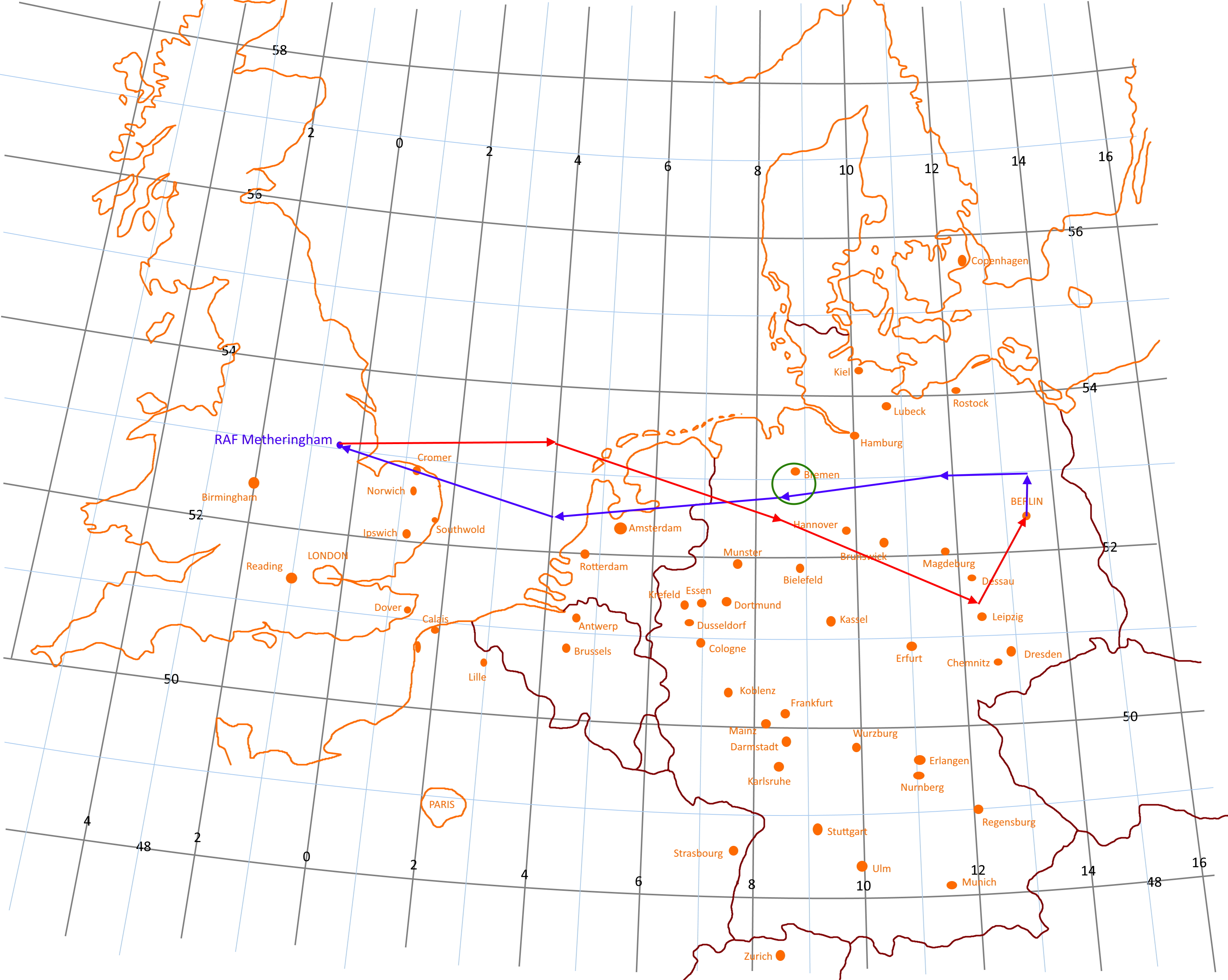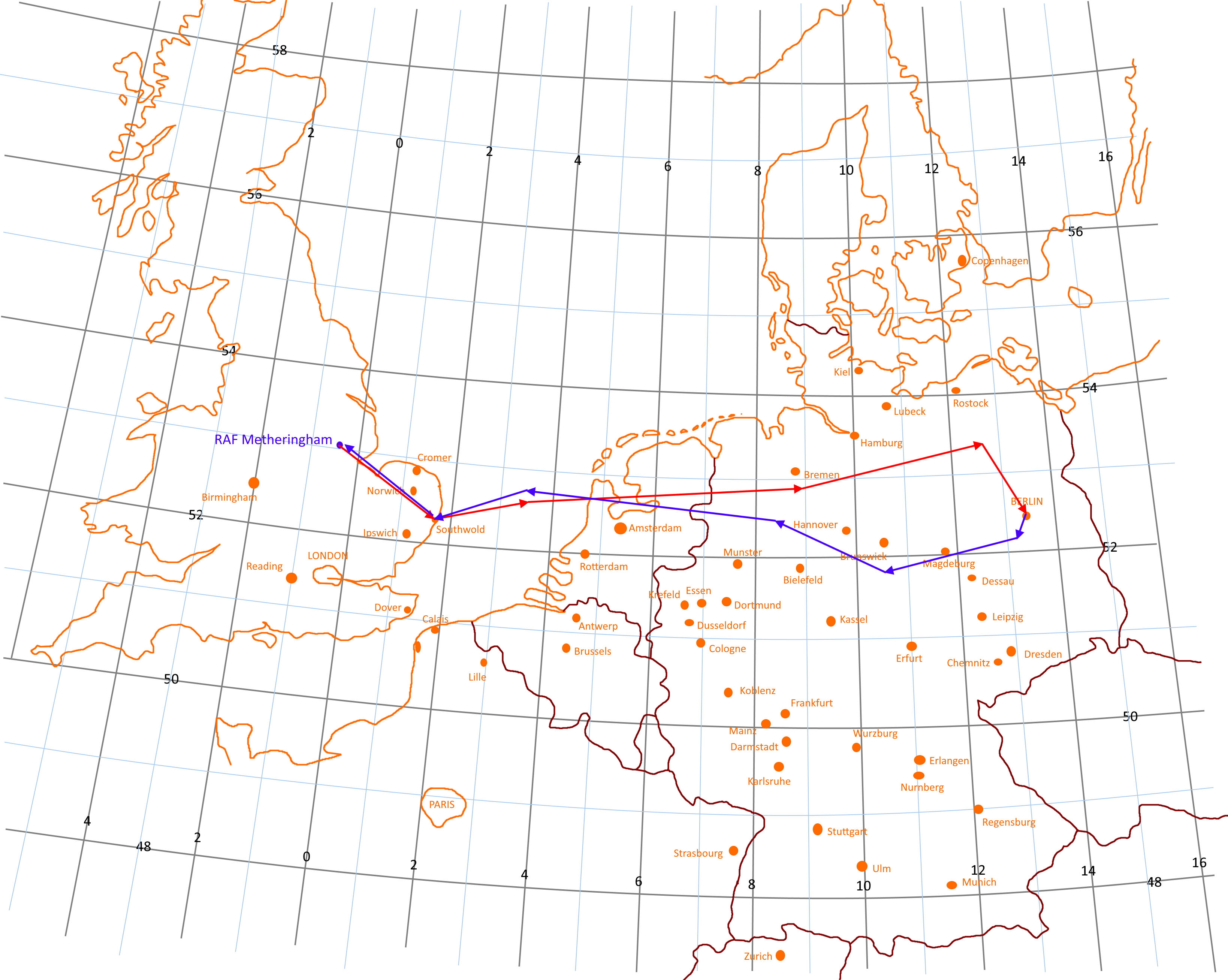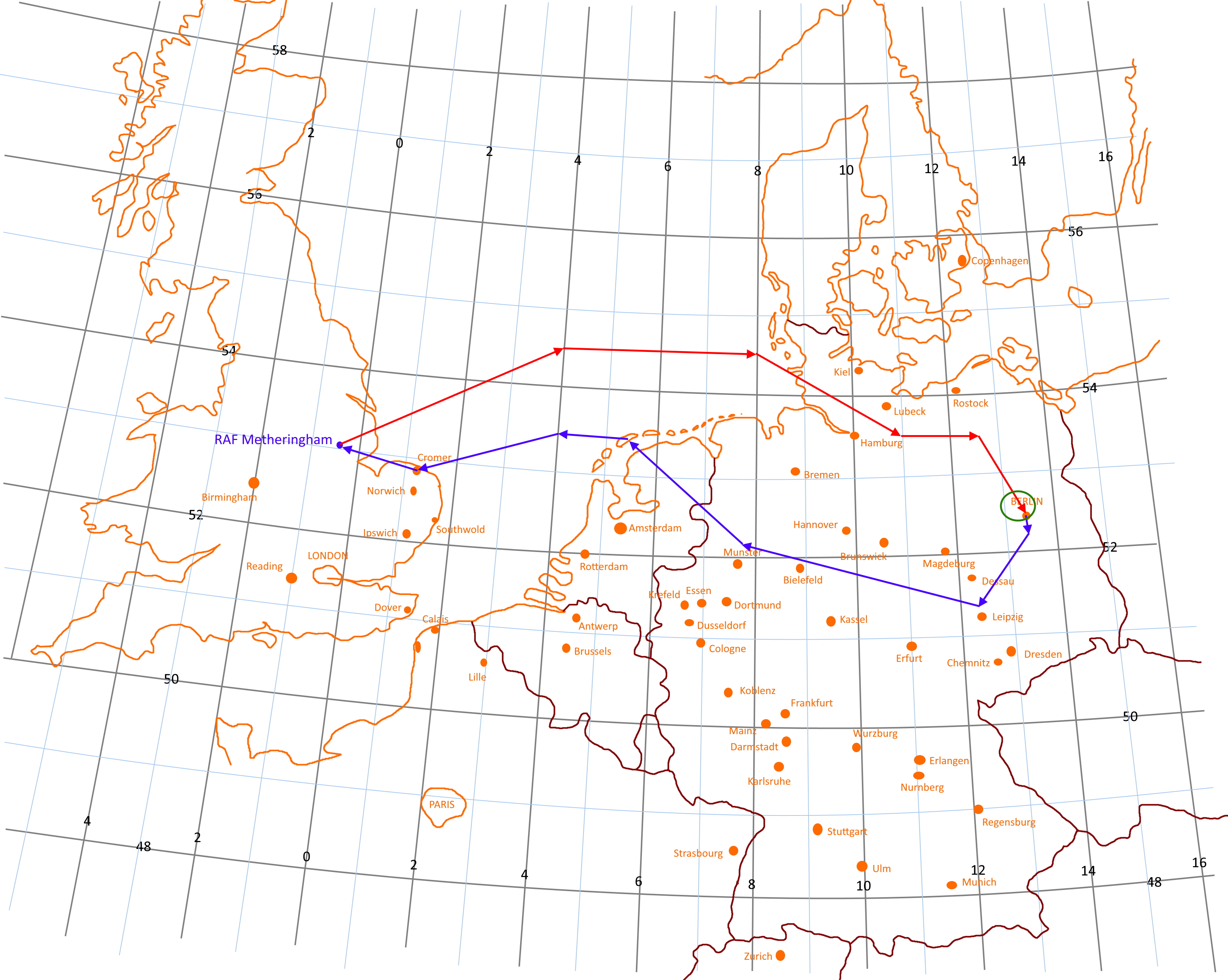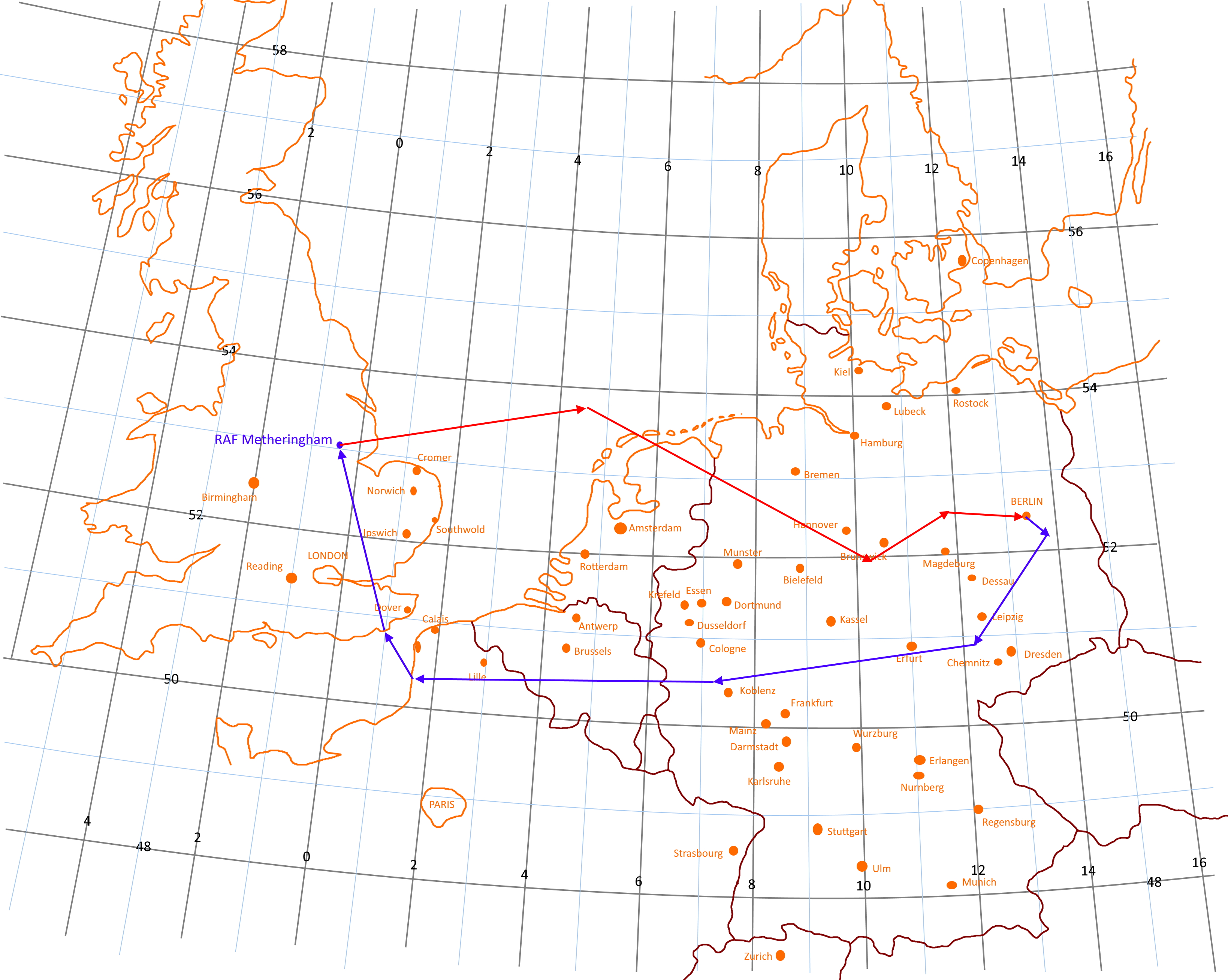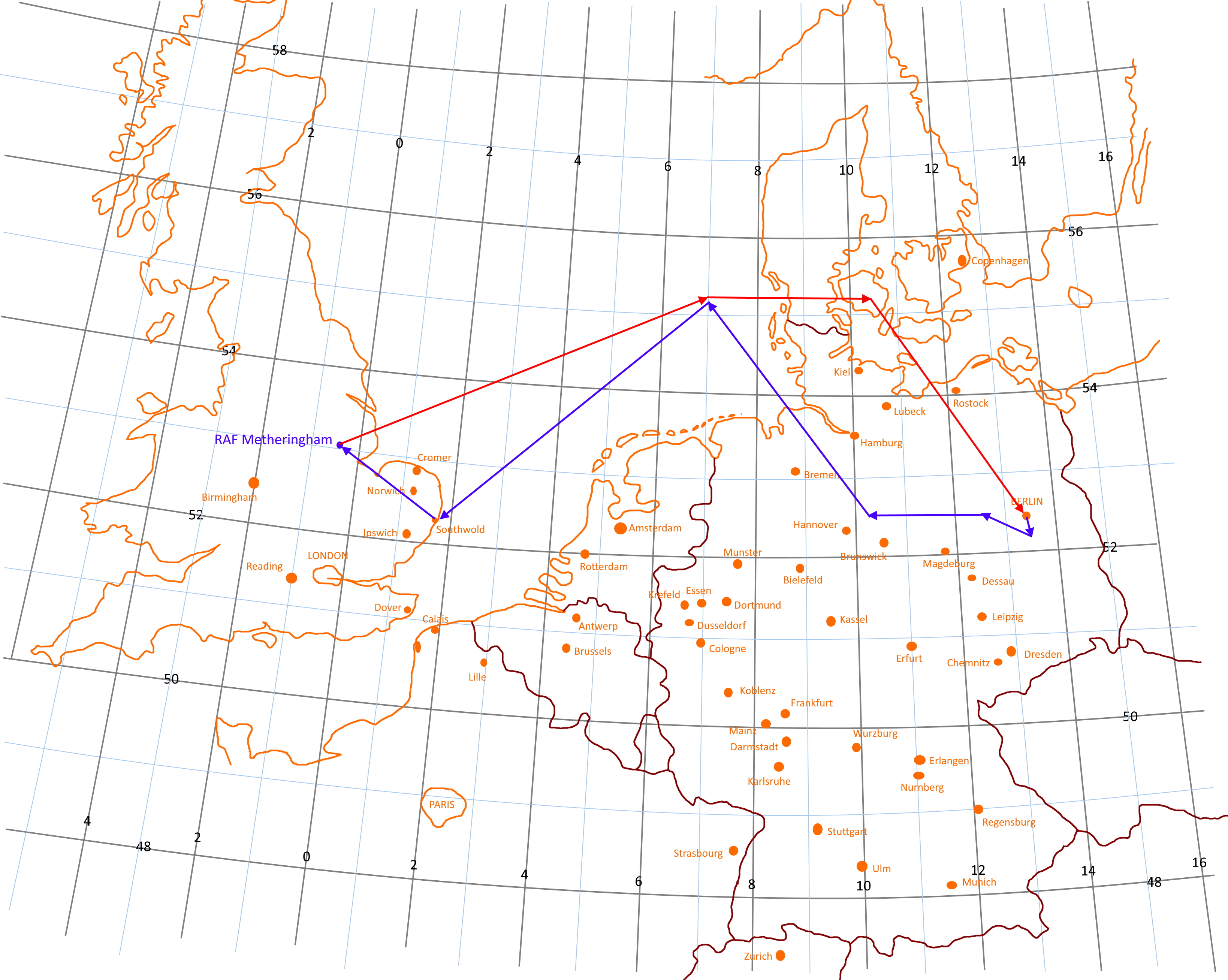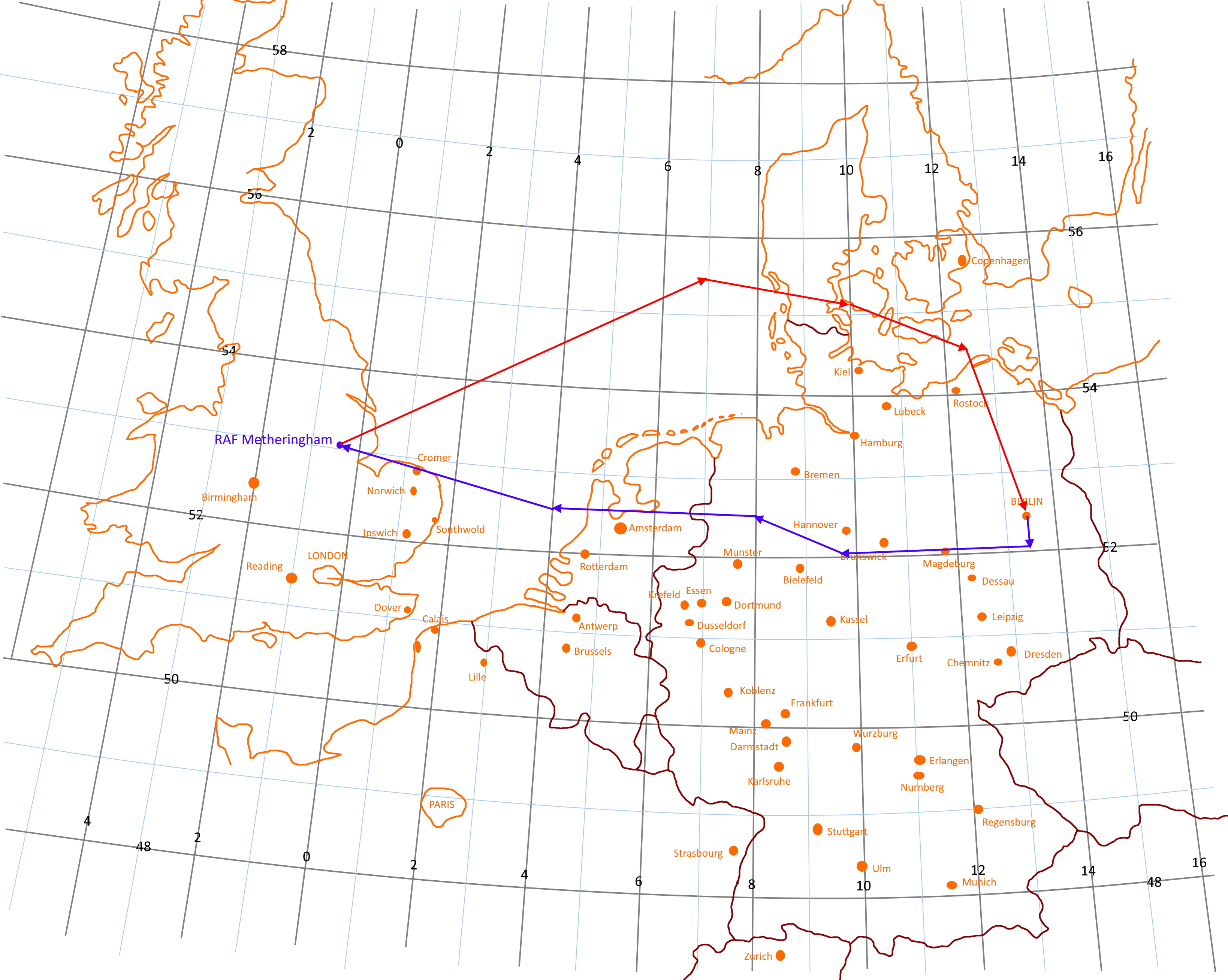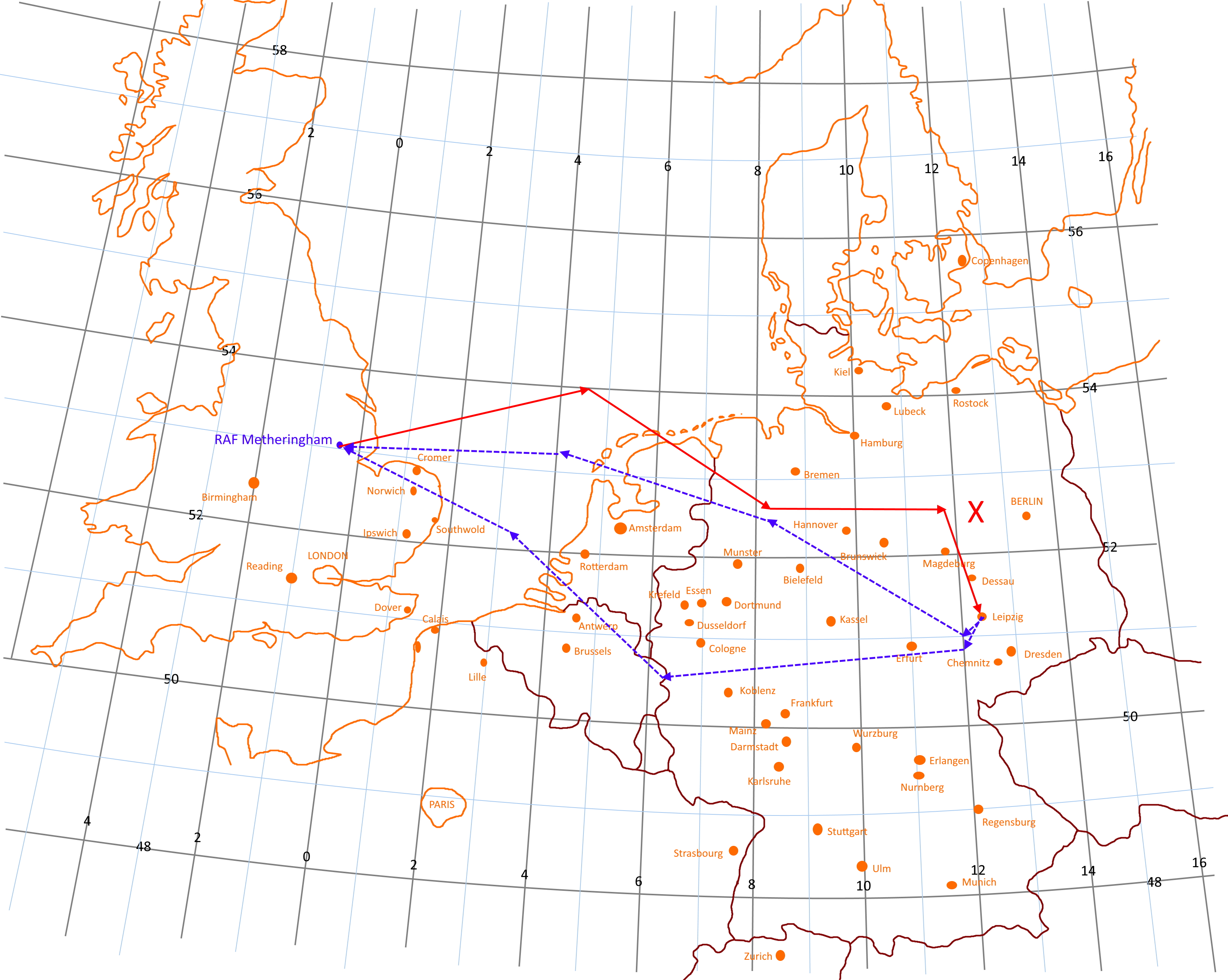THE VILLAGERS OF COLLINGHAM AND LINTON WHO SERVED IN WORLD WAR TWO
COLLINGHAMANDDISTRICTWARARCHIVE.INFO
 CONTACT
CONTACT

Rank Sergeant
Service Number 1590954
Service RAF
Unit 106 Squadron
Regiment Royal Air Force
- Lived in Collingham or Linton immediately prewar or during the war
(Usually taken from 1938 electoral roll or 1939 National Registration roll)
Biography
Notes: Glossary of technical terms used below:
- TI = Target indicator
- Wanganui flares = These were blind-dropped sky markers or flares set to ignite in the air and descend under a small parachute
- Monica = Monica was a range-only tail warning radar for bombers, introduced by the RAF in June 1942.
- IAS = Indicated air speed
- Gee = A radio navigation system used by the Royal Air Force during World War II.
- H2S = H2S was the first airborne, ground scanning radar system. It was developed for the Royal Air Force's Bomber Command during World War II to identify targets on the ground for night and all-weather bombing. It was also widely used as a general navigation system, allowing landmarks to be identified at long range.
Family background
John Cyril Harrison was born on the 15th July 1924 in Kearby with Netherby, Sicklinghall, the son of Allan Harrison and his wife, Ada (nee Wheller). In 1921, Allan was a single, out of work farm horseman, living with his parents in Kearby. In June 1923, Allan married Ada in Collingham Church, and a year later, John Cyril Harrison was born. A few years later, around 1924, the family moved to Collingham, initially living in Main Street, but later moving to Brookside.
Service Record
We do not know exactly when John Cyril Harrison joined the RAF, but we know his first posting was to RAF Dalcross, nowadays Inverness Airport, to No. 2 Air Gunnery School (2 AGS). He was there from 5th June 1943 to 17th July 1943. His first flights were in Avro Ansons. Soon after the outbreak of the Second World War the Anson was found to have become obsolete in front line combat roles. Large numbers of the type were instead put to use as a multi-engined aircrew trainer, having been found to be suitable for the role, and became the mainstay of the British Commonwealth Air Training Plan.
By 12th July 1943, John Harrison had accumulated 19 hours flying time at 2 AGS and he was posted on to 16 Operational Training Unit (16 OTU) based at RAF Heyford located 5 miles north-west of Bicester near the village of Upper Heyford in Oxfordshire. OTUs were training units that prepared aircrew for operations on a particular type of aircraft or roles. 16OTU was formed as part of No 6 Group RAF Bomber Command to train night bomber crews. By 1943 it was using the Wellington bomber in this role. From the 26th July 1943 to the 1st August 1943 John clocked up 8 hours and 25 minutes of flying time in 6 flights training in various operational aspects. Then on the 9th August 1943 he undertook his first night flight, of 4 hours 45 minutes, on a cross country training route from base to Lavenham, Ripon, Filey, Goole, Northampton, Savernake and back to base. Training continued with another cross-country route in daylight from Base to Braintree, Newark, Northampton and back to base on the 10th August 1943.
As part of training at an OTU, special exercises were sometimes arranged, and on the 11th August 1943, John, for the first time, flew over occupied Europe. This special exercise was a leaflet dropping raid to Le Mans, France. Propaganda leaflets were often dropped over France in such missions.
Throughout his flights to date John Harrison was flying as a mid-upper gunner. By the end of his time at 16 OTU, John had amassed 30 hours 10 minutes of daylight flying time and 9 hours 25 minutes at night. His next posting was to 1485 (Bomber) Gunnery Flight School at RAF Skellingthorpe at Lincoln. There he undertook 3 training flights using gunnery with a cine camera gun in various manoeuvres.
His main training over, John was next posted to 1660 Conversion unit at RAF Swinderbury between Newark-on-Trent and Lincoln. It was at Conversion units that full flight crews were formed, and it was at Swinderbury that John Harrison became partnered with Flying Officer E.R.F. Leggett as his pilot. John undertook five flights with F/O Leggett and crew in Halifax bombers from Swinderby, before switching to Lancaster bombers, and he, as part of Leggett's crew then undertook 18 flights in Lancasters. John started this stage of his flying career as a mid-upper gunner, but about half way through his time at 1660 Conversion unit, he switched to be the Rear Gunner, and all the rest of his flights were made in that position. At this stage he had 10 hours 50 minutes experience in Halifaxes and 17 hours 50 minutes in Lancasters.
Finally his crew undertook three Radar Navigation training flights between the 25th October 1943 and 2nd December 1943 to acclimatise the crew to the use of the latest radar navigational devices, before they were posted to his first operational squadron, 106 Squadron, at RAF Metheringham in late November or early December 1943 as a Rear Gunner.
Sergeant John Harrison's first flights with 106 squadron took place in the first few weeks of December 1943. He flew on the 9th December for 1 hour and 15 minutes in Lancaster ZN-P practicing circuits and landing at the airfield in Metheringham. Then on the 10th training continued with bombing practice and an exercise homing using 'Gee'. On the 11th they flew practice cross country exercises. 2 hours 40 minutes in daylight flying using H2S from Metheringham to Norwich, Stoke, Cambridge and back to base; and then at night an exercise of 5 hours 10 minutes, again using H2S from Metheringham to Yeovil, Douglas, Cambridge and back to base. A further daylight cross country route from base to Peterborough, Bradford, Carlisle and home on the 13th December, was then followed by a fighter affiliation training exercise on the 18th December. The crew were then ready for their first operational mission.
Bomber Command designated a number of periods as the 'moon-period' each month when bomber raids were not flown. December's moon stand-down period ended around the 16th and a raid was made on Berlin on the 16th including 106 squadron, but John Harrison's crew was not rostered for that raid. Fog and heavy rain prevented flights for the next couple of days but on the 20th December 1943 John Harrison's operational flights commenced.
First trip
650 aircraft - 390 Lancasters, 257 Halifaxes and three Mosquitoes took part in the raid, with 41 aircraft failing to return. John Harrison's trip however appears to have been more comfortable than some.
Second trip
John's second operational sortie was to Berlin two days before Christmas 1943.
Sgt John Harrison and Flying Officer Payne, as the two gunners, made a combat report about their experiences:
Combat report
1. On the night of December 23 1943 Lancaster T of 106 squadron detailed to attack Berlin had three encounters with the enemy fighters.
2. The first took place at 0153 hours on the outward journey 10 miles north east of Antwerp when the Lancaster at 20,000 feet was flying in on a course of 153 degrees at an IAS of 155 mph. A twin-engined unidentified aircraft was first sighted by the mid upper gunner astern slightly up at a range of 800 yards. The Lancaster he immediately commenced a corkscrew to starboard and at a range of 400 yards both gunners opened fire with fairly the long bursts. The enemy aircraft, which carried a yellow light on the port wing and a white light on the starboard, was seen to extinguish the latter, and then fall behind. After a further burst from the Lancaster’s gunners, the enemy aircraft was lost sight of astern without return fire being experienced. Visibility was good but no searchlights or unusual phenomena was seen. Approximately 400 rounds were expended from the rear turret and 180 from the mid upper, no stoppages being encountered. No claim is made.
3. The second combat took place over the target when the Lancaster was on the bombing run at 20,000 feet flying on a course of 010 degrees at an IAS of 165 mph. On this occasion a JU 88 was sighted by the rear gunner astern slightly below at a range of 200 yards. Almost immediately the enemy aircraft opened fire with machine gun and canon tracer, the Lancaster rear gunner replying with a long burst, at the same time instructing his captain to dive port. The Junkers continued to maintain fire until the range had closed to 100 yards when it was seen to lose height to rapidly and is claimed as damaged. Although there were a number of searchlights in action the Lancaster had not been coned and there were no obvious signs of ground cooperation from there. No damage was inflicted on the Lancaster and most of the enemy tracer was seen to pass well below. Visibility was good and the enemy aircraft was easily visible against the background of target fires and searchlights. Approximately 600 rounds were fired from the rear turret without stoppage and none from the mid upper, the latter gunner of being unsighted. No lights were carried by the JU 88.
4. The third encounter took place on the homeward journey over the Zuider Zee. The Lancaster at the time (0610 hours) was at 25,000 feet flying on a course of 272 degrees at an IAS of 155 mph. The enemy aircraft was first sighted by the flight engineer on the starboard and low level. It was then identified by the captain, Flying Officer Leggate, as a JU 88 and the Lancaster gunners were warned to stand by. The enemy aircraft was then sighted by the rear gunner on the port quarter down at 200 yards and a short burst was fired from the Lancaster tail turret. Range was then increased and the JU 88 temporarily lost sight of. Almost immediately a second JU 88 was seen on the starboard quarter slightly up at 400 yards. After a short burst from the tail gunner this aircraft was seen to dive steeply below the Lancaster and lost sight of. From this stage onwards the two enemy aircraft made repeated but undetermined attacks for approximately 25 minutes, until the Lancaster was 10 miles out to sea from the enemy coast. Only on one occasion was return fire experienced and that was at extreme range from port quarter down. Throughout this period the Lancaster corkscrewed almost continuously, the rear gunner opening fire whenever practicable. Approximately 800 to 1000 rounds were fired from the rear turret no serious stoppages being encountered. The mid upper gunner, however, was unable to expend any ammunition owing to continual No. 1 stoppages being experienced. Both turret and guns were examined and tested the following morning and found to be in working order. The cause of the stoppages remains unknown at present, but is being investigated and a further report will be rendered. No claim is made on either enemy aircraft and no damage was inflicted on the Lancaster. No searchlights or unusual phenomenon was noticed and visibility was good with 8/10th cloud at 12,000 feet. Both Lancaster gunners are of the opinion that the enemy aircraft were having difficulty in positioning themselves for a favourable attack, owing to the relative position of the Moon and their Lancaster i.e. On the fine port quarter level. No lights were carried by either enemy aircraft and at no time during the encounter were simultaneous attacks made on individual range close to less than 300 yards.
Rear gunner 1590954 Sgt Harrison (“2 AGS and 16 OTU) and M/Gunner Aus F/O Payne (15 OTU)
On the 28th December John Harrison flew on a simulation bombing training flight to York and on the 29th the crew was detailed for their third operational raid.
Third trip
John's third operational sortie was again to Berlin on the 29th December 1943.
In "In the Middle of Nowhere - The history of RAF Metheringham" John Harrison told of his experiences that night: On the return leg we were hit by flak (over Bremen) which shattered the cockpit canopy killing the flight engineer outright and badly injuring the wireless operator in the right shoulder. We went into a screaming dive and I was stuck solid in the rear turret unable to move. Dickie [Flying Officer E.R.F. Leggett] , with the help of the bomb aimer, Chubby [Flying Officer F.D. Chubb], managed to pull it out of the dive at about 10000 feet. Both inboard engines were u/s, we had no wireless and both turrets were u/s. We were losing fuel but by throwing everything that was loose out of the door and hatches we managed to make Cotishall by the skin of our teeth. The Wireless Operator was taken to Norwich hospital. In a recorded interview with the Bomber Command Archives, John Harrison recalled that they had to push into the circuit and landing at Cottishall in front of other aircraft that were waiting to land, that they landed and got had got half way down the runway when they ran out of fuel. The aircraft was written off and the uninjured crew were collected by plane and flown back to Metheringham.
On the 31st December 1943, thirteen 106 squadron aircraft were detailed for a raid which was canceled soon after briefing, probably due to weather conditions. We do not know if John and crew were involved. On the 1st January 1944, 106 squadron were involved in another operation against Berlin, but John and crew did not take part. Fifteen 106 squadron aircraft did take part, and this time two failed to return. John would probably have know these crew men and it must have brought home the dangers that Bomber Command was exposed to during the raids.
Fourth trip
Despite the undoubted trauma of their own last flight, the remainder of the crew were back on operations just three days later. The crew had a new Flight Engineer and Wireless Operator, but the target was the same. Back to Berlin!
106 Squadron did not fly on the 3rd January and the 4th was taken up with flying training. John and crew practiced bombing using H2S on a 1 hour 55 minute flight in ZN-N. The moon period then prevented operational flights and it was not until 18th January that John Harrison recorded his next flight, a 20 minute air test, followed by short training flights on the 24th, and 27th January.
Fifth trip
John Harrison's next operation came on the 20th January, when he and the crew went back yet again to Berlin.
Aircraft ZN-N was attacked during this mission, and John Harrison filed a combat report on his return which gives an insight into his experience that night.
Combat report
1. On the night of 20th-21st January at 19.32 hours, Lancaster "N" (Captain F/O Leggett) of 106 Squadron on the run in to the target (Berlin) was attacked by a twin-engined unidentified aircraft. The Lancaster was flying on a course of 165 degrees at a height of 21,000 feet with an I.A.S. of 155. The e/a dived from port quarter up and was first seen by the M/U at a range of 150 yards. Lancaster immediately went into a diving turn to port and at the same time e/a opened fire. Both Rear and M/U Gunners returned fire and e/a broke off attack down starboard. There was 10/10th cloud below and visibility was fair. No searchlights or unusual phenomena at time of combat. The e/a was registered on 'Monica' immediately prior to attack. No damage to Lancaster and no hits claimed on e/a. Mid-Upper fired 100 rounds approx, experiencing no stoppages. Rear Gunner fired 150 rounds approx; experiencing no stoppages.
2. M/U Gunner:- P/O Payne, 15 O.T.U.
R/Gunner: - Sgt Harrison. 2AGS and 16 OTU.
John and the crew were stood down from a 106 squadron raid to Magdeburg on the 21st January and it was about a week later that the crew flew operationally again, meantime undertaking high level bombing exercises and night flying training on the 24th and 27th January.
Sixth trip
A week after their last operational trip, the crew returned again to Berlin.
Seventh trip
Two days later, on the night of the 28th/29th January 1944, John and crew were targetted yet again back to Berlin.
Eighth trip
Another two days later, on the night of the 30th/31st January 1944, John and crew were rostered for another operational trip, yet again back to Berlin.
This time the aircraft containing John Harrison was attacked, and a combat report was filed after the raid:
Combat report
1. On the night of 30th January 1944, Lancaster "A" (Flying Officer Leggett) of 106 Squadron, on homeward journey from BERLIN encountered a ME210 at a position 5200N, 1200E at 2056 hours. The Lancaster at 22,000 feet was travelling on a course of 271M at a speed of 160 IAS. The Rear Gunner first sighted the enemy aircraft dead astern at 600 yards below. He immediately instructed the pilot to corkscrew and the ME210 was then positioned on the port quarter. The Rear and M/U gunners opened fire with three and two-second bursts respectively. The e/a did not close in to continue the attack, but broke away to starboard quarter down without firing at the Lancaster, and was not seen again. The Rear Gunner fired approx. 300 rounds and the Mid Upper about 100 rounds.
2. The visibility was very good with quarter moon, and 10/10th cloud below at 10,000 feet. There were no searchlights or unusual phenomena during the encounter. 'Monica' was serviceable throughout the trip and registered the e/a during the attack.
2. M/U Gunner:- P/O Payne, 15 O.T.U.
R/Gunner: - Sgt Harrison. 2AGS and 16 OTU.
One other 106 squadron aircraft was not so lucky that night. The aircraft piloted by P/O Kirkland was reported missing on this raid.
Early February coincided with the moon-period and a comprehensive training programme was put in place for 106 squadron, but John Harrison did not record any flights in his log book.
Ninth trip
After a couple of weeks break, on the night of the 15th/16th February 1944, John and crew undertook their 9th mission to Germany. Once again the target was Berlin.
Nineteen 106 squadron aircraft took part in this raid. One of the aircraft (Captain F/O Forsyth, DFC) who was making his last operational sortie, was hit by incendaries from another aircraft but survived. The aircraft piloted by Flying Office Dickerson, was not so lucky. Having completed their trip and bombed Berlin, they crashed close to base at Timberland Fen. They had been avoiding another aircraft. Four crew were killed outright, and Sergeant Hills died later the same day from his injuries.
Tenth trip
John Harrison's 10th operational sortie with 106 Squadron came on the night of the 19th February 1944.
Aircraft ZN-P of 106 Squadron was shot down on the outward bound leg of the trip by night fighter pilot Oberleutnant Paul Zorner of the 8.NJG 3, who was flying a Messerschmidt Bf 110 G-4 D5+FS, from Luneburg airfield in Niedersachsen. The bomber crashed into the Brietlingsee lake.
John's parents received a letter dated 26th February 1944.
Sir,
I am commanded by the Air Council to express to you their great regret on learning that your son, Sergeant John Cyril Harrison, Royal Air Force, is missing as the result of air operations on the night of 19/20th February 1944, when a Lancaster aircraft in which he was flying as rear gunner set out to bomb Leipzig and was not heard from again.
This does not necessarily mean that he is killed or wounded, and if he is a prisoner of war he should be able to communicate with you in due course. Meanwhile enquiries are being made through the International Red Cross Committee, and as soon as any definite news is received you will be at once informed.
If any information regarding your son is received by you from any source you are requested to be kind enough to communicate it immediately to the Air Ministry.
The Air Council desires me to convey to you their sympathy in your present anxiety.
I am, Sir, Your obedient Servant,
John's parents made enquiries themselves about John's fate, and received a letter dated 3rd March 1944 from the Wounded, Missing and Relatives Department of the War Organisation of the British Red Cross and Order of St.John:
Dear Mrs Harrison,
We have received your enquiry in which you ask for news of your son, Sergeant J.C. Harrison, 1590954.
We are so sorry to tell you that no information has been received about him up to the present, but all possible enquiries are being made. Any news which may be forthcoming from the International Red Cross Committee at Geneva or from any other source will be passed to you immediately. If, however, you are the registered next-of-kin, your first notification will come from the Air Ministry.
Yours sincerely,
In fact John had been taken as prisoner of war. In "In the Middle of Nowhere - The history of RAF Metheringham" John Harrison told his own story:
We were shot down by a ME110 just as we were making our last turn near Brunswick to head for Leipzig. The fighter attacked from underneath and slightly to the rear, and although I saw it, gave evasive action and opened fire, he managed to get a burst into the petrol tanks and also hit the fuselage towards the rear. We were unable to put the fires out and Dickie [Flying Officer E.R.F. Leggett] gave the order to bail out. The mid upper and myself tried to bale out from the rear exit but the door was damaged and would not open, so we had to make our way up the fuselage and go out by the front exit. I was the last to go and I saw that Dickie was still at the controls, he gave me a thumbs up sign and I felt him release my flying boot which had got caught on something. Dickie did not get out. Why I do not know. He looked alright but he may have been injured during the attack by the fighter, or the aircraft may have blown up before he got out. Whatever happened there is no doubt that he saved our lives by staying at the controls.
Captured Aircrew were first taken to Dulag Luft prisoner of war camp before processing and onward transport to their final camps. John Harrison passed through Dulag Luft near Frankfurt before being a prisoner at Stalag Luft VI prisoner of war camp at Heydekrug, now in modern day Lithuania, and then at Stalag 357, Kopernikus, at Thorn in Poland. Sergeant 1590954 John Harrison, became Prisoner of War number 1733. Sergeant E.F. Windeatt and Sergeant T.H. Jones followed the same route through the same camps. As Officers, the other crew followed different routes. Flying Officer N.C.F. Bloy, Flying Officer (later Flight Lieutenant) F.B. Chubb, and Flying Officer S.W. Payne all became prisoners of war at Stalag Luft III, at Sagan, the prisoner of war camp famous for The Great Escape which had taken place a little before they arrived at the camp. At the end of the war prisoner of war camps were forcibly evacuated as the Allied and Russian Armies advanced and the prisoners were subjcted to long marches to other camps. As part of these movements we have found that Flight Lieutenant Chubb was left at Marlag and Milag Nord camp from where he was repatriated, but we don't have specific details for John Harrison.
After the war
After the war John Harrison returned to the UK, and became a police officer. in 1946, John married in Collingham, as reported at the time:
Th marriage took place at St. Oswald's, Collingham, on Saturday, of Flt.-Sergt. John Cyril Harrison, only son of Mr. and Mrs. A. Harrison, of Brookside, Collingham, and Miss Joan Prince, elder daughter of Mr. and Mrs. G.W. Prince, of Brownhill Terrace, Leeds. The wedding was attended by two of the bridegroom's former fellow prisoners of war.
Captured in February, 1944, when he baled out of his blazing bomber during a night raid over Leipzig, the bridegroom was taken to Stalag Luft 3, and later to Stalag 357, where he met six other prisoners who arranged to attend each other;s weddings. This is the first to take place, but only two of the group, W/O R. Cage and Flt-Sergt. R. Atkinson, were able to attend the ceremony.
The bride, who was given away by her father, was attended by her sister, Miss Jill Prince, and Miss Mary Harrison, sister of the bridegroom. The Rev. J.B. Unthank officiated.
We believe that John Cyril Harrison died in Dewsbury in 2017.
Biography last updated 08 January 2024 13:28:55.
If you have any photographs or further details about this person we would be pleased to hear from you. Please contact us via: alan.berry@collinghamanddistrictwararchive.info


